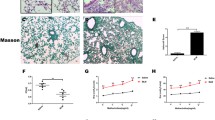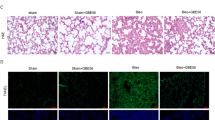Abstract
Pachymic acid (PA), a natural extract from Poria cocos (Schw.) Wolf, possesses anti-inflammatory and anti-oxidative properties. However, it is still unknown whether PA can protect against bleomycin (BLM)-induced pulmonary fibrosis (PF). In this study, we investigated the effects of PA in mice administered BLM. Our results showed that PA significantly improved lung damage and pathological manifestations. Additionally, PA reduced the levels of interleukin (IL)-6 and tumor necrosis factor (TNF)-α, while increasing the level of IL-10. PA also decreased the levels of hydroxyproline and malondialdehyde, and increased the activities of superoxide dismutase and glutathione peroxidase in lung tissue. Furthermore, PA inhibited the increases in pyrin domain-containing protein 3 (NLRP3), ASC, IL-1β, P20, and TXNIP induced by BLM. In conclusion, our study demonstrated the protective effects of PA against BLM-induced PF in mice by suppressing fibrotic, inflammatory, and oxidative stress pathways.










Similar content being viewed by others
Data Availability
All data included in this study are available upon request by contact with the corresponding author.
Abbreviations
- PF :
-
Pulmonary fibrosis
- BLM :
-
Bleomycin
- PA :
-
Pachymic acid
- BALF :
-
Bronchoalveolar lavage fluid
- MDA :
-
Malondialdehyde
- GPX :
-
Glutathione peroxidase
- SOD :
-
Superoxide dismutase
- GSH-Px :
-
Plasma glutathione peroxidase
- HYP :
-
Determination of hydroxyproline
- NLRP3 :
-
Pyrin domain-containing protein 3
References
Tsoyi, K., Chu, S. G., Patino-Jaramillo, N. G., Wilder, J., Villalba, J., Doyle-Eisele, M., McDonald, J., Liu, X., El-Chemaly, S., Perrella, M. A., & Rosas, I. O. (2018). Syndecan-2 attenuates radiation-induced pulmonary fibrosis and inhibits fibroblast activation by regulating PI3K/Akt/ROCK pathway via CD148. American Journal Of Respiratory Cell And Molecular Biology, 58, 208–215.
**e, Y., Jiang, H., Zhang, Q., Mehrotra, S., Abel, P. W., Toews, M. L., Wolff, D. W., Rennard, S., Panettieri, R. A. Jr., Casale, T. B., & Tu, Y. (2016). Upregulation of RGS2: A new mechanism for pirfenidone amelioration of pulmonary fibrosis. Respiratory Research, 17, 103.
Desai, O., Winkler, J., Minasyan, M., & Herzog, E. L. (2018). The role of immune and inflammatory cells in idiopathic pulmonary fibrosis. Front Med (Lausanne), 5, 43.
Liu, M. W., Su, M. X., Tang, D. Y., Hao, L., Xun, X. H., & Huang, Y. Q. (2019). Ligustrazin increases lung cell autophagy and ameliorates paraquat-induced pulmonary fibrosis by inhibiting PI3K/Akt/mTOR and hedgehog signalling via increasing miR-193a expression. Bmc Pulmonary Medicine, 19, 35.
Suzuki, T., Tada, Y., Gladson, S., Nishimura, R., Shimomura, I., Karasawa, S., Tatsumi, K., & West, J. (2017). Vildagliptin ameliorates pulmonary fibrosis in lipopolysaccharide-induced lung injury by inhibiting endothelial-to-mesenchymal transition. Respiratory Research, 18, 177.
Judge, J. L., & Nagel, D. J. (2018). Prevention and treatment of bleomycin-induced pulmonary fibrosis with the lactate dehydrogenase inhibitor gossypol. PLoS One, 13, e0197936.
Cabrera, S., Maciel, M., Herrera, I., Nava, T., Vergara, F., Gaxiola, M., López-Otín, C., Selman, M., & Pardo, A. (2015). Essential role for the ATG4B protease and autophagy in bleomycin-induced pulmonary fibrosis. Autophagy, 11, 670–684.
Dong, Y., Geng, Y., Li, L., Li, X., Yan, X., Fang, Y., Li, X., Dong, S., Liu, X., Li, X., et al. (2015). Blocking follistatin-like 1 attenuates bleomycin-induced pulmonary fibrosis in mice. Journal Of Experimental Medicine, 212, 235–252.
Ma, J., Liu, J., Lu, C. W., & Cai, D. F. (2015). Pachymic acid modified carbon nanoparticles reduced angiogenesis via inhibition of MMP-3. International Journal of Clinical and Experimental Pathology, 8, 5464–5470.
Cheng, S., Swanson, K., Eliaz, I., McClintick, J. N., Sandusky, G. E., & Sliva, D. (2015). Pachymic acid inhibits growth and induces apoptosis of pancreatic cancer in vitro and in vivo by targeting ER stress. PLoS One, 10, e0122270.
Li, F. F., Yuan, Y., Liu, Y., Wu, Q. Q., Jiao, R., Yang, Z., Zhou, M. Q., & Tang, Q. Z. (2015). Pachymic acid protects H9c2 cardiomyocytes from lipopolysaccharide-induced inflammation and apoptosis by inhibiting the extracellular signal-regulated kinase 1/2 and p38 pathways. Molecular Medicine Reports, 12(2), 2807–2813.
Li, J. Y., Wu, H. X., & Yang, G. (2017). Pachymic acid improves survival and attenuates acute lung injury in septic rats induced by cecal ligation and puncture. European Review for Medical & Pharmacological Sciences, 21, 1904.
Total glycosides of Yu**feng protects. (2015). Against bleomycin-induced pulmonary fibrosis in rats associated with reduced high mobility group box 1 activation and epithelial–mesenchymal transition. Inflammation Research, 64, 953–961.
Karampitsakos, T., Woolard, T., Bouros, D., & Tzouvelekis, A. (2017). Toll-like receptors in the pathogenesis of pulmonary fibrosis. European Journal of Pharmacology, 808, 35–43
Khazdair, M. R., Boskabady, M. H., & Ghorani, V. (2015). Respiratory effects of sulfur mustard exposure, similarities and differences with asthma and COPD. Inhalation Toxicology, 27(14), 731–744.
Duan, X., Wen, Z., Shen, H., Shen, M., & Chen, G. (2016). Intracerebral hemorrhage, oxidative stress, and antioxidant therapy. Oxidative Medicine and Cellular Longevity, 2016, 1203285.
He, R., Cui, M., Lin, H., Zhao, L., Wang, J., Chen, S., & Shao, Z. (2018). Melatonin resists oxidative stress-induced apoptosis in nucleus pulposus cells. Life Sciences, 199, 122–130.
Heink, A. E., Parrish, A. N., Thorgaard, G. H., & Carter, P. A. (2013). Oxidative stress among SOD-1 genotypes in rainbow trout (Oncorhynchus mykiss). Aquatic Toxicology, 144–145, 75–82.
Zhang, L., Gao, Z., Yu, L., Zhang, B., Wang, J., & Zhou, J. (2018). Nucleotide-binding and oligomerization domain (NOD)-like receptors in teleost fish: Current knowledge and future perspectives. Journal Of Fish Diseases, 41, 1317–1330.
Liu, W., Guo, W. J., Xu, Q., & Sun, Y. (2016). [Advances in mechanisms for NLRP3 inflammasomes regulation]. Yao Xue Xue Bao = Acta Pharmaceutica Sinica, 51, 1505–1512.
Kelley, N., Jeltema, D., Duan, Y., & He, Y. (2019). The NLRP3 inflammasome: An overview of mechanisms of activation and regulation. International Journal of Molecular Sciences, 20(13), 3328.
Cáceres, F. T., Gaspari, T. A., Samuel, C. S., & Pinar, A. A. (2019). Serelaxin inhibits the profibrotic TGF-β1/IL-1β axis by targeting TLR-4 and the NLRP3 inflammasome in cardiac myofibroblasts. The FASEB Journal, 33, 14717–14733.
Author information
Authors and Affiliations
Contributions
WSM, TW, and JHB performed the experiments, analyzed the data, and wrote the paper. WSM, ZL, and JHL designed the present study and provided experimental materials. All authors read and approved the final manuscript.
Corresponding author
Ethics declarations
Ethical Approval
All experiments of animals were approved by the Institutional Animal Care and Use Committee of Shanghai Pulmonary Hospital.
Conflict of Interest
The authors declare no competing interests.
Additional information
Publisher’s Note
Springer Nature remains neutral with regard to jurisdictional claims in published maps and institutional affiliations.
Rights and permissions
Springer Nature or its licensor (e.g. a society or other partner) holds exclusive rights to this article under a publishing agreement with the author(s) or other rightsholder(s); author self-archiving of the accepted manuscript version of this article is solely governed by the terms of such publishing agreement and applicable law.
About this article
Cite this article
Wang, S., Tan, W., Zhang, L. et al. Pachymic Acid Protects Against Bleomycin-Induced Pulmonary Fibrosis by Suppressing Fibrotic, Inflammatory, and Oxidative Stress Pathways in Mice. Appl Biochem Biotechnol 196, 3344–3355 (2024). https://doi.org/10.1007/s12010-023-04686-5
Accepted:
Published:
Issue Date:
DOI: https://doi.org/10.1007/s12010-023-04686-5




